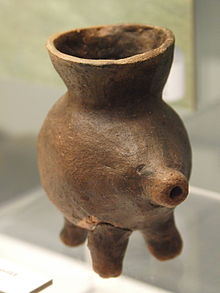Baby bottle
The baby bottle , also known as teat bottle , also called "Schoppen" in Switzerland and southern Germany, is a bottle with an attached , pacifier-like suction device that is used to supply liquid food for infants . In the first few months she has pumped breast milk or infant formula, later it can also juice or tea included.
Current bottle sizes are 125 ml, 240 ml and 330 ml. The teats are usually available with a number of one to four openings, their use depends on the age of the child and the viscosity of the contents. Some teats have valve systems that are designed to prevent air being swallowed while sucking, which could later lead to colic .
The reasons for feeding babies with the feeding bottle are different: they range from hospitalization of the infant or mother due to operations to personal aversions of the mother or infant to breastfeeding . Colloquially, such infants are also called bottle- fed children .
The early childhood caries is a form of tooth decay, which is connected with the bottle feeding. It is therefore recommended to switch after the age of 12 months.
It is important to clean the teat and bottle thoroughly after use so that germs cannot multiply in them. After cleaning, the bottle is sterilized by boiling it in a water bath, a steam sterilizer or in a special container in the microwave.
materials
Bottles made of glass and polycarbonate , which have fallen into disrepute because of the bisphenol A they contain , are common. In the EU, both the production and sale of baby bottles made from plastics containing BPA has been banned since 2011. Since glass bottles have the disadvantage that they are heavier and more fragile, the alternative polypropylene has quickly gained acceptance. It is free from BPA or other harmful plasticizers. Teats are usually made of latex and silicone . The latter is not as firm to the bite as it is, but less allergic.
Canada has classified bisphenol A as dangerous and has banned polycarbonate baby bottles.
warming
The contents are preheated to body temperature for babies for health reasons. This can be done in a water bath or with a special baby bottle warmer. Heating in the microwave is not suitable as the contents heat up unevenly and scalding can result. In the case of bottles made of polycarbonate, bisphenol A is also increasingly released into the food.
history
In ancient times, the vessels were made of clay. From the 16th century leather and wood were used for the production, from the 17th also cow horns. The suckers were made of leather or cotton. From the 19th century on, beer bottles with a cotton rag were also used. A rubber teat was later placed over the edge of the bottle. In the 1930s, latex teats came on the market. Polycarbonate has also been used for the bottles since the early 1960s .
Web links
swell
- ↑ Sueddeutsche.de: Bisphenol A, "Guerilla War" about a plastic base (November 3, 2007)
- ↑ Sueddeutsche.de: Poison from the baby bottle? (February 24, 2010)
- ↑ Spiegel.de: Plasticizers could damage brain tissue (December 13, 2005)
- ↑ European Commission - PRESS RELEASES - Press release - Bisphenol A: EU ban on baby bottles comes into force tomorrow. Accessed January 31, 2019 .
- ↑ Canada bans poisonous baby bottles. Welt Online, May 1, 2008, accessed September 17, 2008 .
- ↑ Poison in Milk ( Memento from March 21, 2004 in the Internet Archive )
- ↑ The history of the feeding bottle (English) ( Memento from November 21, 2007 in the Internet Archive )


